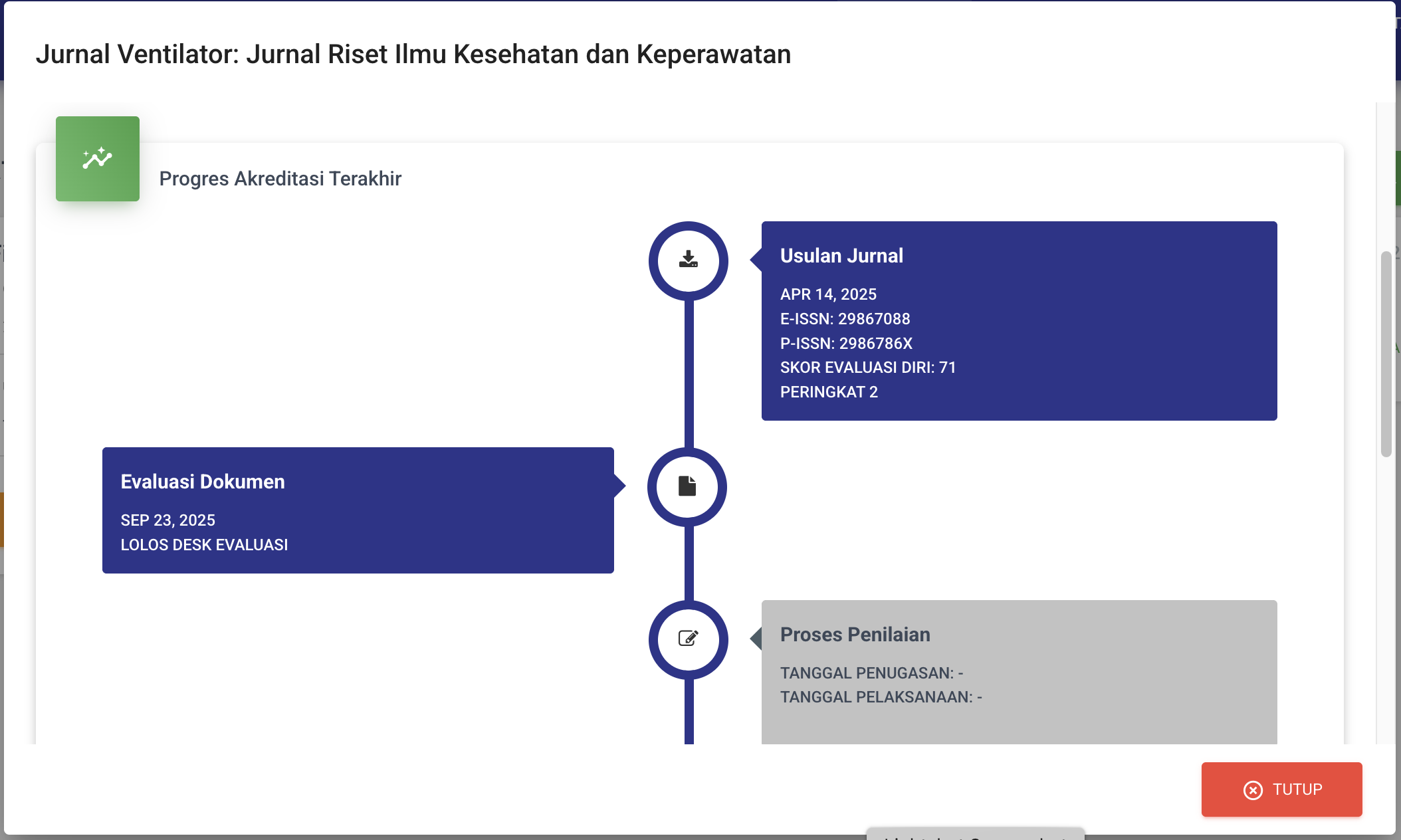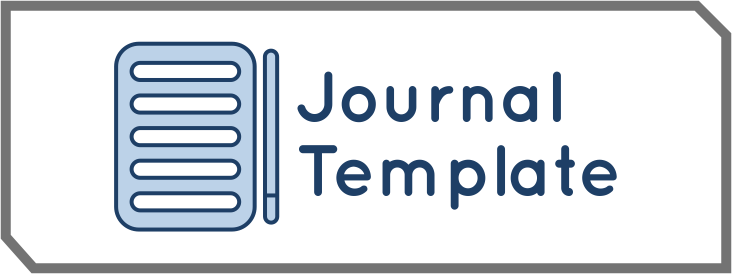Efikasi Diri Menurunkan Kendala dalam Berperilaku Sehat
DOI:
https://doi.org/10.59680/ventilator.v1i1.338Abstract
Healthy behaviours are formed because individuals make decisions and commit to continuing habits that support the improvement or maintenance of health. Self-efficacy gives confidence to individuals to achieve goals to achieve good health conditions, but it is not uncommon for individuals to experience barriers in the commitment process. This study aims to determine the relationship between self-efficacy and barrier to healthy behaviour. Researchers used cross section as a research design to take parameters of 186 respondents taken randomly which then the data will be analyzed in descriptive and inferential correlations. The results showed that there was a significant moderate positive relationship between self-efficacy and obstacles to healthy behaviour. Therefore, it is recommended to provide health services that focus on increasing confidence in individuals in order to reduce the constraints felt and prescribed by individuals and can study other factors that can also reduce barriers in healthy behaviour.
References
Adriani, Oktavia, S., & Febrina, W. (2021). Efektivitas Pendidikan Kesehatan Terhadap Perilaku Cuci Tangan Pakai Sabun Dalam Upaya Pencegahan Covid-19. REAL in Nursing Journal, 4(2), 77. https://doi.org/10.32883/RNJ.V4I2.1268
Alligood, M. R. (2014). Nursing Theorists and Their Work. Missouri: Elseiver.
Alyahya, M. S., Al-Sheyab, N. A., Alqudah, J. A., Younis, O. B., & Khader, Y. S. (2021). Effect of Multimedia Messaging Service on Exercise Self-efficacy in Diabetic Patients. American Journal of Health Behavior, 45(5), 902–915. https://doi.org/10.5993/AJHB.45.5.10
Ausrianti, R., Andayani, R. P., Surya, D. O., & Suryani, U. (2020). Edukasi Pencegahan Penularan Covid 19 serta Dukungan Kesehatan Jiwa dan Psikososial pada Pengemudi Ojek Online. Jurnal Peduli Masyarakat, 2(2), 59–64. https://doi.org/10.37287/jpm.v2i2.101
Bamonti, P. M., Moye, J., Harris, R., Kallmi, S., Kelly, C. A., Middleton, A., & Bean, J. F. (2022). Development of a Coaching Protocol to Enhance Self-efficacy Within Outpatient Physical Therapy. Archives of Rehabilitation Research and Clinical Translation, 4(2), 100198. https://doi.org/10.1016/J.ARRCT.2022.100198
Barrett, E. A. M. (2010). Power as Knowing Participation in Change: What’s New and What’s Next. Nursing Science Quarterly, 23(1), 47–54. https://doi.org/10.1177/0894318409353797
Cirillo, A. (2016). RStudio for R Statistical Computing Cookbook. Retrieved from https://www.packtpub.com/big-data-and-business-intelligence/rstudio-r-statistical-computing-cookbook
Corpuz, J. C. G. (2021). Adapting to the culture of “new normal”: an emerging response to COVID-19. Journal of Public Health (Oxford, England), 43(2), e344–e345. https://doi.org/10.1093/pubmed/fdab057
Darmawan, A., Qoriana, D. E., & Henggaranyanti, S. (2021). Sosialisasi program perilaku cuci tangan pakai sabun untuk meningkatkan pengetahuan cuci tangan pakai sabun dan pencegahan covid-19 | Darmawan | PROMOTIF: Jurnal Pengabdian Kepada Masyarakat. PROMOTIF: Jurnal Pengabdian Kepada Masyarakat, 1(2), 81–88. Retrieved from http://journal2.um.ac.id/index.php/promotif/article/view/23122/8992
Dehdari, T., Rahimi, T., Aryaeian, N., & Gohari, M. R. (2014). Effect of nutrition education intervention based on Pender’s Health Promotion Model in improving the frequency and nutrient intake of breakfast consumption among female Iranian students. Public Health Nutrition, 17(3), 657–666. https://doi.org/10.1017/S1368980013000049
Faul, F., Erdfelder, E., Buchner, A., & Lang, A.-G. (2009). Statistical power analyses using G*Power 3.1: Tests for correlation and regression analyses. Behavioral Research Methods, 41(4), 1149–1160. https://doi.org/10.3758/BRM.41.4.1149
Faul, F., Erdfelder, E., Lang, A.-G., & Buchner, A. (2007a). G*Power 3.1 manual. Behavioral Research Methods, 39(2), 175–191. https://doi.org/10.3758/BF03193146
Faul, F., Erdfelder, E., Lang, A.-G. G., & Buchner, A. (2007b). G*Power 3: A flexible statistical power analysis program for the social, behavioral, and biomedical sciences. Behavioural Research Methods, 39(2), 175–191. https://doi.org/10.3758/BF03193146
Green, L. W., & Ottoson, J. M. (2006). A Framework for Planning and Evolution and Application of the Model PRECEDE-PROCEED Model.
Hayden, J. (2019). Introduction to Health Behavior Theory. In Jones & Bartlett Learning (3rd ed., Vol. 3). Burnington, MA.: Jones & Bartlett Learning.
Kamimura, A., Nourian, M. M., Jess, A., Chernenko, A., Assasnik, N., & Ashby, J. (2016). Perceived benefits and barriers and self-efficacy affecting the attendance of health education programs among uninsured primary care patients. Evaluation and Program Planning, 59, 55–61. https://doi.org/10.1016/J.EVALPROGPLAN.2016.08.006
Koerniawan, D., Frisca, S., Indaryati, S., Anita, T., & Fruitasari, M. (2022). Pendampingan Masyarakat Mengenali Faktor Pemberat (Comorbid) Covid–19. Indonesian Journal Of Community Service, 2(2), 180–187. Retrieved from http://ijocs.rcipublisher.org/index.php/ijocs/article/view/181%0Ahttps://ijocs.rcipublisher.org/index.php/ijocs/article/download/181/130
Mawarti, H., Simbolon, I., Purnawinadi, I. G., Khotimah, Pranata, L., Simbolon, S., … dkk. (2021). Pengantar Riset Keperawatan. Medan: Yayasan Kita Menulis. Retrieved from https://books.google.co.id/books?hl=en&lr=&id=yi5LEAAAQBAJ&oi=fnd&pg=PA32&ots=aO_awuEm1U&sig=JBQHQ91Nk07OzqWv0-JQzgkewWA&redir_esc=y#v=onepage&q&f=false
Michie, S., van Starlen, M. M., & West, Ro. (2011). The behaviour change wheel: A new method for characterising and designing behaviour change interventions. Implementation Science, 6(42), 1–11. https://doi.org/10.1001/archderm.1985.01660070119033
Pagano, R. R. (2010). Understanding Statistics in Behavioural Science (9th ed.). Cengage Learning.
Papadakos, J., Barnsley, J., Berta, W., Rowlands, G., Samoil, D., & Howell, D. (2022). The association of self-efficacy and health literacy to chemotherapy self-management behaviors and health service utilization. Supportive Care in Cancer, 30(1), 603–613. https://doi.org/10.1007/S00520-021-06466-5/METRICS
Peterson, S. J., & Bredow, T. S. (2011). Middle range theories: Application to nursing research: Third edition. In Middle Range Theories: Application to Nursing Research: Third Edition.
Prasetyani, D., & Rahayu, Y. S. E. (2021). Edukasi dan pendampingan kader tentang manajemen diri lansia dengan komorbid diabetes melitus pada era pandemi COVID-19 di kelurahan Sidanegara Kabupaten Cilacap. Indonesia Berdaya, 2(1), 41–46. https://doi.org/10.47679/ib.202167
Putra, P. W. K., Suardani, N. N., Ariani, N. P. E., & Suarsih, N. P. A. (2022). The Smartphone-Based Self Management Education Improves Compliance and Self Efficacy and Reduces Blood Pressure in Hypertension Patients. Journal of Health Education, 7(2), 107–114. https://doi.org/10.15294/JHE.V7I2.59843
RStudio Team. (2015). RStudio: Integrated Development Environment for R. Boston, M.A. Retrieved from http://www.rstudio.com/
Schmuller, J. (2020). Statistical Analysis with R for Dummies. In Suparyanto dan Rosad (2015 (Vol. 5).
Seiter, C. R. (2021). Benefit, Barrier, and Self-Efficacy Messages in Advance Care Planning Education Materials. Health Communication, 36(11), 1397–1404. https://doi.org/10.1080/10410236.2020.1754601
Sulmasy, D. P., Hughes, M. T., Yenokyan, G., Kub, J., Terry, P. B., Astrow, A. B., … Nolan, M. T. (2017). The Trial of Ascertaining Individual Preferences for Loved Ones’ Role in End-of-Life Decisions (TAILORED) Study: A Randomized Controlled Trial to Improve Surrogate Decision Making. Journal of Pain and Symptom Management, 54(4), 455–465. https://doi.org/10.1016/j.jpainsymman.2017.07.004
Supardi. (2013). Aplikasi Statistika dalam Penelitian: Konsep Statistika yang lebih Komprehensif. Jakarta: Change Publication.
WHO. (2022). World Health Statistics 2022. Geneva: World Helath Organization.
WHO. (2023). World Health Statistics 2023. Geneva.
Wikurendra, E. A. (2018). Pengaruh Penyuluhan Cuci Tangan Pakai Sabun Terhadap Sikap mencuci Tangan Siswa kelas IV di SDN Sukomoro I dan III Kecamatan Sukomoro Kabupaten Ngajui. Jurnal Ilmiah Kesehatan Media Husada, 7(2), 65–70. https://doi.org/10.33475/JIKMH.V7I2.21
Zhang, A., Wang, J., Wan, X., Zhang, J., Guo, Z., Miao, Y., … Yang, W. (2022). Mediation Effect of Self-Efficacy Between Health Beliefs and Glycated Haemoglobin Levels in Elderly Patients with Type 2 Diabetes Mellitus: A Cross-Sectional Study. Patient Preference and Adherence, 16, 3015. https://doi.org/10.2147/PPA.S388967







